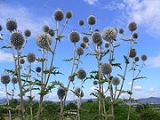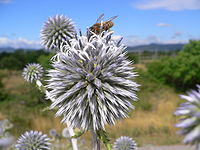
Echinops sphaerocephalus
Encyclopedia
Echinops sphaerocephalus, known by the common name Great globe thistle or Pale globe-thistle, is a species of globe thistle
belonging to the family Asteraceae
.
 This is a glandular, woolly perennial herbaceous
This is a glandular, woolly perennial herbaceous
plant which reaches on average 50–100 cm (19.7–39.4 ) of height, with a maximum of two metres.
Its erect, branching, gray, slightly wrinkled and hairy stems bear the occasional large, soft, sharply toothed, sharp-lobed pointed green leaves. They are sticky hairy above, and white woolly below.
Atop each stem is an almost perfectly spherical inflorescence
up to 6 cm in diameter, packed with white or blue-gray disc florets
. It flowers from June until September.
The flowers are pollinated by insects (usually bees, wasps and butterflies) (entomogamy) and are hermaphrodite
(self fertilization or autogamy). The fruits are hairy cylindrical achene
s about 7 to 8 mm long. They ripe from September through October. The seed dispersal is granted by wind (anemochory).
, including North America where it is a widespread weed. It is very common in the mountains of southern France and southern and central Europe.
Echinops
Echinops is a genus of about 120 species of thistles in the daisy family Asteraceae, commonly known as globe thistles. They are native to Europe east to central Asia and south to the mountains of tropical Africa.Species include:...
belonging to the family Asteraceae
Asteraceae
The Asteraceae or Compositae , is an exceedingly large and widespread family of vascular plants. The group has more than 22,750 currently accepted species, spread across 1620 genera and 12 subfamilies...
.
Etymology
The genus name derives from the Greek words "ekhinos" meaning "hedgehog" and "opisis" meaning "aspect", with reference to the appearence of the inflorescence, while the species name sphaerocephalus derives from the words "sphaera" meaning "round" and "kephalos" meaning head.Description

Herbaceous
A herbaceous plant is a plant that has leaves and stems that die down at the end of the growing season to the soil level. They have no persistent woody stem above ground...
plant which reaches on average 50–100 cm (19.7–39.4 ) of height, with a maximum of two metres.
Its erect, branching, gray, slightly wrinkled and hairy stems bear the occasional large, soft, sharply toothed, sharp-lobed pointed green leaves. They are sticky hairy above, and white woolly below.
Atop each stem is an almost perfectly spherical inflorescence
Inflorescence
An inflorescence is a group or cluster of flowers arranged on a stem that is composed of a main branch or a complicated arrangement of branches. Strictly, it is the part of the shoot of seed plants where flowers are formed and which is accordingly modified...
up to 6 cm in diameter, packed with white or blue-gray disc florets
Head (botany)
The capitulum is considered the most derived form of inflorescence. Flower heads found outside Asteraceae show lesser degrees of specialization....
. It flowers from June until September.
The flowers are pollinated by insects (usually bees, wasps and butterflies) (entomogamy) and are hermaphrodite
Glossary of botanical terms
Many of the terms used in Wikipedia glossaries are already defined and explained within Wikipedia itself. However, lists like the following indicate where new articles need to be written and are also useful for looking up and comparing large numbers of terms together.This glossary is incomplete;...
(self fertilization or autogamy). The fruits are hairy cylindrical achene
Achene
An achene is a type of simple dry fruit produced by many species of flowering plants. Achenes are monocarpellate and indehiscent...
s about 7 to 8 mm long. They ripe from September through October. The seed dispersal is granted by wind (anemochory).
Distribution
This species is native to Eurasia but it lives on other continents where it was introducedIntroduced species
An introduced species — or neozoon, alien, exotic, non-indigenous, or non-native species, or simply an introduction, is a species living outside its indigenous or native distributional range, and has arrived in an ecosystem or plant community by human activity, either deliberate or accidental...
, including North America where it is a widespread weed. It is very common in the mountains of southern France and southern and central Europe.
Habitat
It grows in sunny, rocky or brushy places, with more or less rich in minerals soils, at an altitude of 0–400 m (0–1,312.3 ) above sea level.Subspecies
- Echinops sphaerocephalus L. subsp. albidus (Boiss. et Spruner) Kozu.
- Echinops sphaerocephalus L. subsp. sphaerocephalus
External links
- ASTERACEAE, SUNFLOWER FAMILY, The Jepson Manual
- USDA Plants Profile
- Globe Thistle, Ontario Weeds
- Echinops sphaerocephalus, alterVISTA
- Biolib

